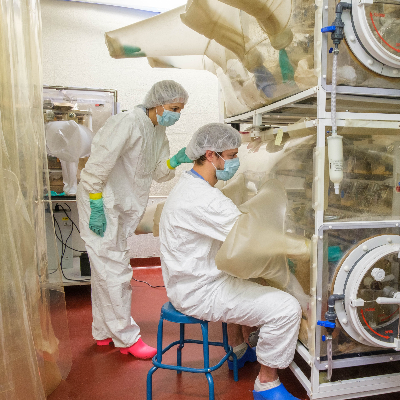 Pictured: Dr. Elena Verdú and Mike Rosatti, gnotobiotic animal care technologist, who is conducting health checks of germ-free mouse colonies at McMaster’s Axenic Gnotobiotic Unit.
Pictured: Dr. Elena Verdú and Mike Rosatti, gnotobiotic animal care technologist, who is conducting health checks of germ-free mouse colonies at McMaster’s Axenic Gnotobiotic Unit.
In a
new study funded by Crohn’s and Colitis Canada, researchers have for the first time uncovered bacterial changes in the gut that precede the development of ulcerative colitis. These transformations are potential new markers for inflammation for which people at risk of colitis could be proactively monitored – and treated with precision drugs.
The gut microbiome consists of bacteria and other microscopic life forms that inhabit our gastrointestinal tract. It is a key area of investigation for inflammatory bowel disease (IBD), with new molecular techniques enabling researchers to identify which bacteria are colonizing the gut and what their effects are.
According to Dr. Elena Verdú, lead author on the paper from McMaster University and a Crohn’s and Colitis Canada-funded researcher, the main challenge is that once ulcerative colitis is diagnosed, we can’t tell if these changes in the gut were caused by the disease or occurred beforehand.
“Much of what we know about the gut microbiome and IBD is after the disease has set in,” says Dr. Verdú. “But finding the microbiota changes that may in fact trigger colitis has proven difficult.”
To search for such potential underlying triggers of ulcerative colitis, Dr. Verdú turned to the Crohn’s and Colitis Canada Genetic, Environmental, Microbial
(GEM) Project. Launched in 2008, the GEM Project is a vital long-term study that has enrolled and tracked over 5,000 immediate family members of people with Crohn’s disease across 107 global recruitment sites.
Team finds signs of inflammation before disease develops
Some GEM Project participants have in fact gone on to develop ulcerative colitis (UC). For Dr. Verdú, this was a chance to investigate whether changes in the gut associated with UC are present before someone is diagnosed.
Metagenomics is a technique where researchers can search the entire genomic makeup at once. Dr. Verdú and her team used this technique to analyze microbiota differences in three groups:
- Pre-UC (healthy, without UC symptoms)
- UC (have symptoms, diagnosed with UC)
- Healthy controls (those who never developed disease)
Unsurprisingly, they found the UC group had a different bacterial composition and gene activity than the other groups. The most interesting finding was that the pre-UC group – those who would later develop the disease – also had functional differences in the gut. In that group, Dr. Verdú’s team found differences in bacterial genes regulating proteases, and confirmed this activity was
higher than in people who did not develop UC.
“This suggested that this proteolytic activity can be detected before ulcerative colitis is diagnosed,” says Dr. Verdú. “This could be an important biomarker of disease progression or may increase the chances of developing colitis by promoting inflammation in the gut.”
Next, using germ-free mice housed in McMaster’s Axenic Gnotobiotic Unit, the research team was able to confirm that this unique bacterial composition – the “proteolytic signature” – was in fact driving inflammation in the gut.
A new window on treatment possibilities
The findings offer a new glimpse into the early stages of UC, and unlock newfound potential to delay or prevent the disease altogether.
“Testing for this proteolytic signature could be a way for us to identify those who are at greater risk for ulcerative colitis before active disease even sets in,” says Dr. Verdú. “Anti-proteolytic drugs – which are already in development – could then be administered as a possible treatment to prevent disease.”
For Navjit Moore, president of the Crohn’s and Colitis Canada Fraser Valley East Chapter, this is a welcome development.
“As someone with ulcerative colitis, I’m excited by how these findings can help shape future screening techniques and preventative treatments,” says Moore, who is pursuing a Doctor of Pharmacy at the University of British Columbia.
“The IBD community across Canada works extremely hard to raise funds to support research like this, and it’s so great to see the positive outcomes of our collective efforts. We are so appreciative of how researchers dedicate years to finding causes and cures for IBD, and bring a greater understanding of these diseases that carry such a huge impact on the lives of so many Canadians.”
Dr. Verdú says the support from Crohn’s and Colitis Canada and the volunteers who raise funds has enabled researchers across the country to make significant progress. “This support is what makes my research team’s discoveries possible.”